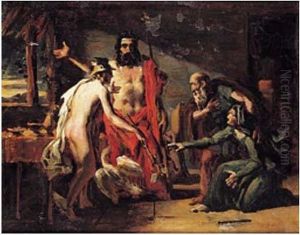Michel Marigny Paintings
Michel Marigny, born in 1625, was a French engraver and publisher whose contributions to the art world, though less widely known today, were significant during his lifetime and the Baroque period. Not to be confused with more prominent figures of his era, Marigny navigated the complex art scene of 17th-century France, a time when the arts flourished under the patronage of the monarchy and the influence of the Académie Royale de Peinture et de Sculpture, established in 1648.
Marigny's work primarily involved the engraving process, a technique that was essential for reproducing and disseminating artworks, making them accessible to a broader audience beyond the elite and the court. This period saw a growing interest in prints and books that illustrated scientific discoveries, maps, and artworks, catering to the expanding intellectual curiosity of the European population. Engravers like Marigny played a crucial role in this cultural expansion, contributing to the spread of knowledge and artistic appreciation across the continent.
His career spanned a period marked by significant political and social changes in France, including the reign of Louis XIV, known as the Sun King, who was a great patron of the arts. The establishment of the French Academy in Rome, the construction of the Palace of Versailles, and the centralization of artistic production under the king's control were pivotal developments that shaped the context in which Marigny worked. Despite the overshadowing fame of contemporaries such as Nicolas Poussin, Claude Lorrain, and Charles Le Brun, Marigny managed to carve out a niche for himself within the realm of engraving and publishing.
Marigny's legacy, though not as prominent as that of his contemporaries, is preserved in collections and archives that hold examples of his work. His engravings, characterized by meticulous detail and technical skill, serve as a testament to the craftsmanship and aesthetic sensibilities of the Baroque period in France. They not only illustrate Marigny's own artistic talent but also offer insights into the visual culture of his time.
He died in 1694, leaving behind a body of work that, while not widely recognized today, contributed to the rich tapestry of 17th-century French art. Marigny's engravings continue to be of interest to historians and collectors who seek to understand the complexities of Baroque art and its dissemination through printmaking.
